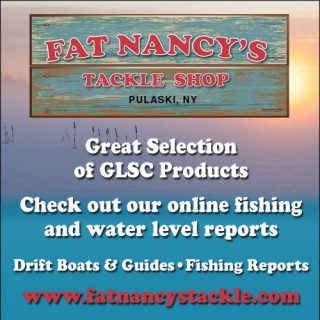By Zack RAYNO, Founder of Great Lakes Steelhead Co.
Nowadays, the options for steelhead and trout fishing seem endless. Choosing and rigging a bait can seem daunting, but an evaluation of your river surroundings can make this choice easy.
Trick Em Beads and Jigs are my go-to baits while scouring the tributaries of Lake Ontario, but when is appropriate to fish a bead vs. a jig? First, I analyze where the fish are. For example, in early fall when water temperatures are high, steelhead tend to hold in quick riffles. This faster water is perfect for bead fishing. As fall turns to winter and the water temperature drops, steelhead begin retreating to the deeper pools and slower water. This slow drift is classic for fishing a jig underneath a float.
Next, consider what the fish are feeding on. During spawning periods, you can bet there are eggs floating around in the water. Grab your bead box! This holds true not only for Lake Ontario’s tributaries, but also for inland streams where fish are spawning. Just as steelhead gorge themselves behind spawning salmon in the fall, inland trout enjoy an easy meal behind spawning fish as well.
No spawning fish around? No problem! How about baitfish? Jigs mock the sharp movement of minnows perfectly and serve as a great imitation. Whether it’s gizzard shad wandering into the lower Oswego River or smelt making their spawning run on a Lake George tributary, jigs are an effective tool.
Now that we’ve decided what kind of bait to use, it’s time to pick a color and size. Nowadays, the options seem endless. Trick Em Beads are available in over 200 colors and sizes 6,8,10 and 12mm, each with its own purpose. Again, analyze fishing conditions. When deciding bead size, look at the size of the egg you are trying to mimic. Big Chinook Salmon eggs? Try a 10mm. Small trout egg? Time to bust out the 6mm beads.
Water clarity also influences size and color choice. When fishing clear conditions, I stick to the natural light oranges and yellows in a size true to the egg. Colors like All-In, Cheeze Doodle and Egg-Zacktly in sizes 6mm and 8mm are very effective.
When fishing turbid water, I brighten my color selection and utilize UV enhanced baits in bigger sizes. Super UV Orange, Atomic Yellow and Tangy in 10mm and 12mm are favorites of mine.
These same considerations dictate jig selection as well. The Salmon River in Pulaski, NY often flows low and clear during the winter. I like to run 1/64 oz. and 1/32 oz. jigs in natural tones like Ghost Marabou, Cotton Candy Marabou, Kalamata Bunny and Gingersnap Bunny.
Travel a bit west to the Oswego River and you may find high and turbid water flows. Time to bump up to 1/16 oz. and 1/8 oz. jigs with a little more flash. Dirty Girl Bunny, Ecto Crafty and Shocker Shimmy jigs are all viable options.
Now it’s time to rig up! But, how? Centerpin fishing with beads differs from jigs. I still begin with split shot tapered in weight beneath the float, but as they say, the devil lies in the details.
When I am throwing a bead at fish, I like to keep my shot pattern heavy, enough weight to keep a 6-8g float riding properly. I also tend to keep my leader length relatively short, between 15 and 18 inches. This helps to keep your bait in the strike zone. As I switch gears to jigs, I lighten things up. My shot pattern is decreased down to a 4-5g float. I also increase my leader length, about 20-24 inches. In doing this, I let the jig move more freely.
At first glance, hundreds of colors options in multiple sizes can seem disheartening. But, after breaking down river conditions and keeping a wide selection of baits with you, hook-ups are right around the corner. Now get out and fish!



